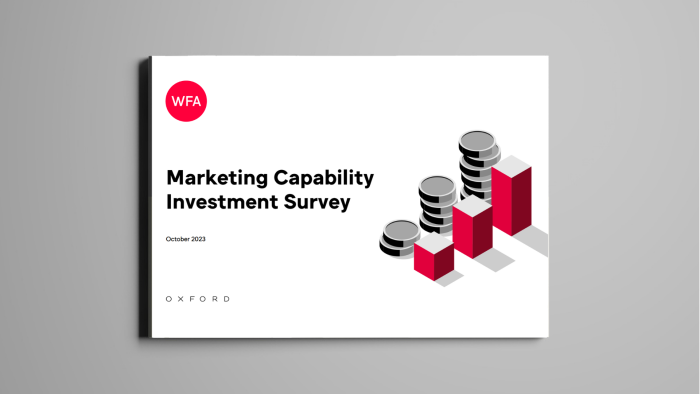Marketing capability: the soft reply to a hard question
Marketing and marketing teams can look different company by company. But the overarching goal of marketing capability remains the same: to continuously improve teams and the work they produce.
Share this post

This joint research by WFA and Oxford provides anonymised data on investment in marketing capability building to enable budget benchmarking against comparable, global companies.
This means more than ‘just’ training. The aim of marketing capability is to cultivate a culture of learning within a marketing team. This is no easy feat, but it is worthwhile, especially from a business perspective.
We see here a virtuous circle: investment in a marketing capability programme leads to better training, which in turn leads to a more upskilled marketing team. This team then delivers higher quality outputs, which ultimately (and ideally) result in positive business growth.
There are some common issues, particularly for marketing capability leaders. These include: the drive to increase programme participation, the debate around the ideal frequency of trainings, and the challenge of presenting tangible metrics to demonstrate the correlation between training and business growth.
Because there is no ‘one size fits all’ solution, working groups such as WFA’s Marketing Capability Forum are incredibly valuable. The forum allows a small community of global senior marketing capability leaders to connect and share their perspectives. This means they too can benefit from a learning culture amongst peers.
Something that should come as no surprise is that forum members unanimously believe in the value of investing in capability building. This investment is a vital part of an ever-evolving process of upskilling and enhancing marketing teams, to produce quality work that results in positive business growth. It is truly an ‘investment in people.’
WFA and OxfordSM recently presented results from a ‘joint capability investment benchmark’ study at a Marketing Capability forum. Here are five key takeaways:
- The long-term trend is for continued investment in capabilities
Investment in people continues to trend upwards amongst medium and large-sized businesses, with smaller businesses beginning to follow suit. - Content is front-of-mind from a budget-line perspective
The development and deployment of content makes up over half of capability budget spend, at a 55%. - Support, belief, and evidence all help further capability investment
WFA members reported that factors contributing to the retainment or increase of capability budgets include: CMO support, organisational belief in capability building, credible metrics, a continued demand for trainings, and overall business growth/expansion. - A hybrid approach to training is preferred
In a post-pandemic workplace, marketing capability leaders seem to have settled on a 70:30 ratio between virtual and in-person delivery of trainings. - Most training participants are from marketing teams, with other audiences included in broader programmes
Marketing and trade/shopper marketing make up nearly half (46%) of the audience served by capability programmes. Some programmes do however go further, to audiences including functional divisions (media, insights, etc.), in-house agencies, external agencies & partners.
If culture feels like a soft metric, just remember: there’s nothing soft about the return on investments when you take the time to advance marketing capabilities.
WFA member? Download the full benchmark results here.
Interested in learning more about the WFA marketing capability forum? Reach out to Brenna Brandes.





